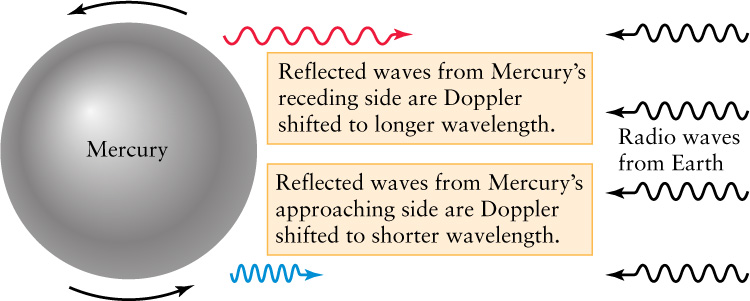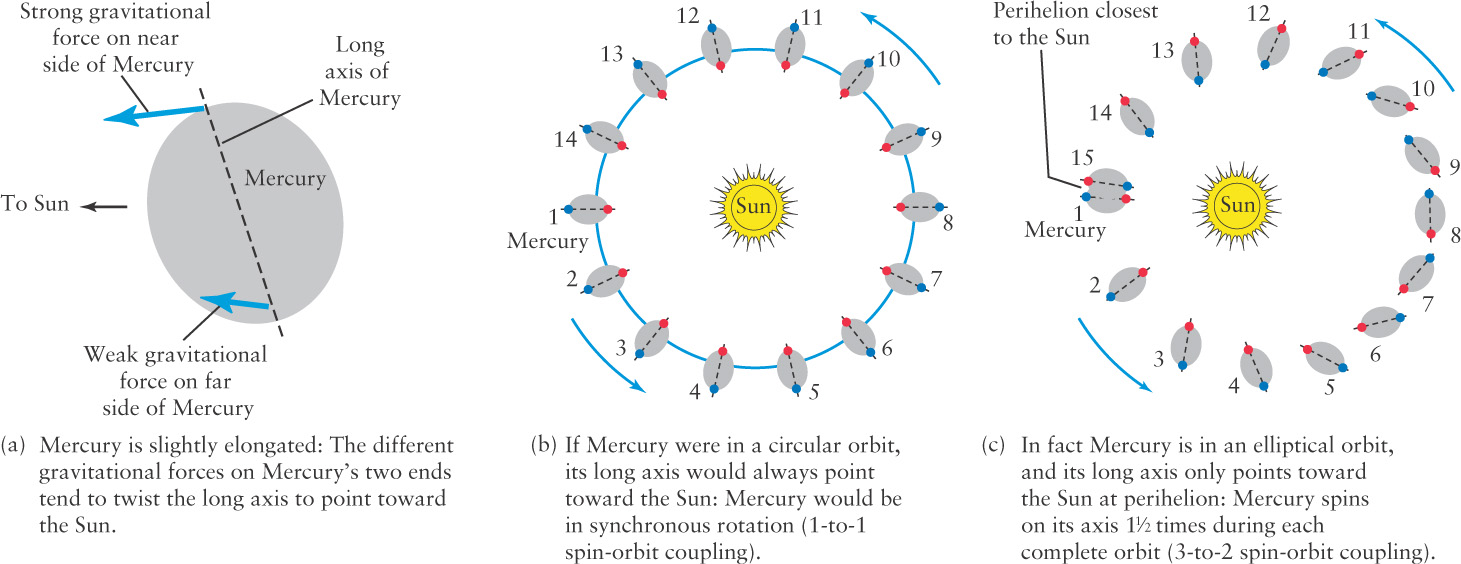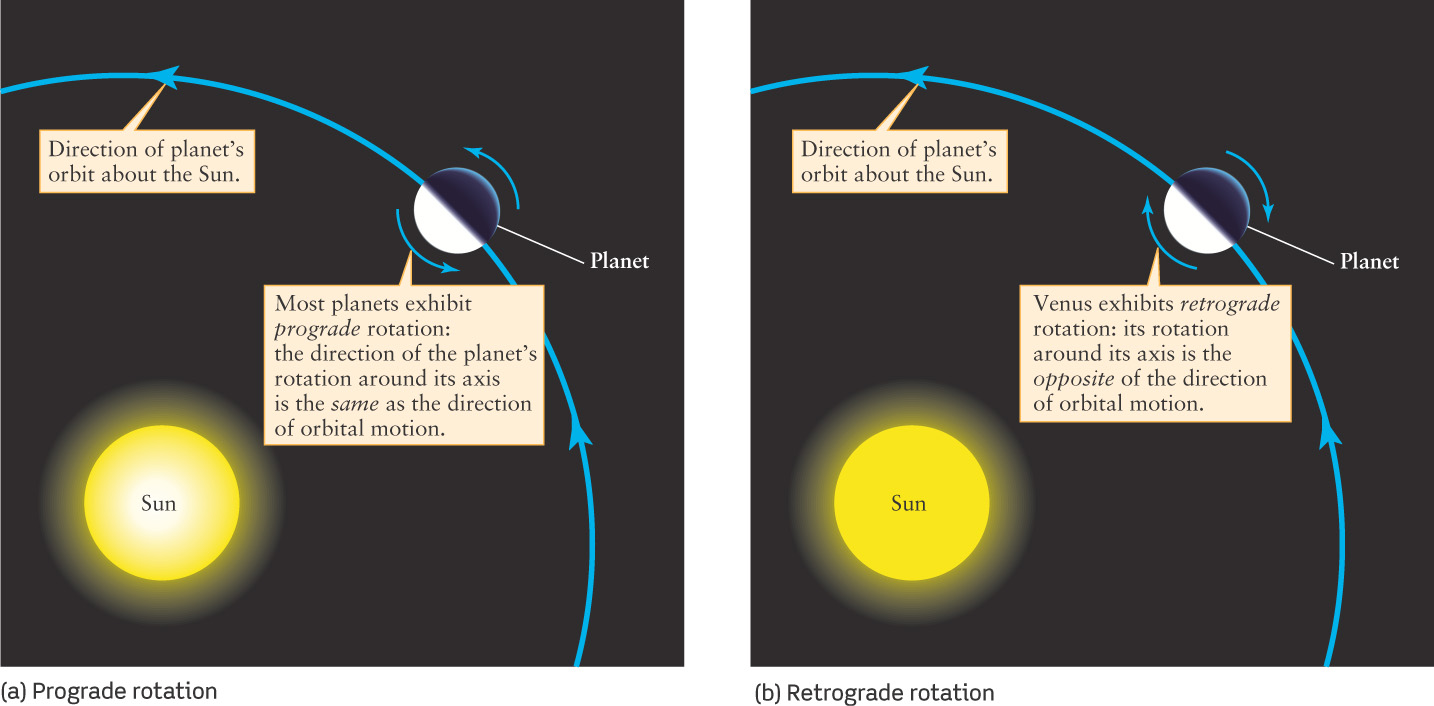11-2 While Mars rotates much like Earth, Mercury’s rotation is coupled to its orbital motion and Venus’s rotation is slow and retrograde
Radar technology revealed the curious rotation of Mercury and Venus
Mars is relatively easy to observe with visible-light telescopes, and by tracking patches of color, its rotation has been measured. By contrast, only a few faint, hazy features can be seen on Mercury’s surface, and the surface of Venus is perpetually hidden by clouds. These differences explain why the rotation of Mars has been well understood since the mid-seventeenth century, while it was not until the 1960s that astronomers accurately measured the rotation of Mercury and Venus. As we will see, Mars rotates in a very Earthlike way, while Mercury and Venus rotate like no other objects in the solar system.
279
The Rotation of Mars
 In 1659, the first reliable record of surface features on Mars was made by the Dutch scientist Christiaan Huygens, who observed a dark feature appear and disappear for several weeks. Huygens concluded that the rotation period of Mars—one day on Mars—is approximately 24 hours, surprisingly similar to a day on Earth.
In 1659, the first reliable record of surface features on Mars was made by the Dutch scientist Christiaan Huygens, who observed a dark feature appear and disappear for several weeks. Huygens concluded that the rotation period of Mars—one day on Mars—is approximately 24 hours, surprisingly similar to a day on Earth.
Also like Earth, Mars’s axis of rotation is not perpendicular to the plane of the planet’s orbit, but is tilted by about 25° away from the perpendicular. This tilt is very close to Earth’s 23½° tilt (see Figure 2-12). This striking coincidence means that Mars experiences Earthlike seasons, with opposite seasons in the northern and southern Martian hemispheres (see Section 2-5). Because Mars takes nearly 2 (Earth) years to orbit the Sun, the Martian seasons last nearly twice as long as on Earth.
The Challenge of Observing Mercury’s Rotation
During the 1880s, the Italian astronomer Giovanni Schiaparelli attempted to make the first map of Mercury. Unfortunately, Schiaparelli’s telescopic views of Mercury were so indistinct that he made a major error, which went uncorrected for more than half a century. He erroneously concluded that Mercury always keeps the same side facing the Sun. As we will see in Section 11-4, it was not Schiaparelli’s last error.
Many objects in our solar system are in synchronous rotation, so that their rotation period equals their period of revolution—a situation also called 1-to-1 spin-orbit coupling. We saw in Section 4-8 how Earth’s tidal forces keep the Moon in synchronous rotation, so that it always keeps the same side toward Earth. Tidal forces also keep the two moons of Mars with the same side facing their parent planet, and likewise many of the satellites of Jupiter and Saturn.
It had been suggested as early as 1865 that the Sun’s tidal forces would keep Mercury in synchronous rotation (resulting in one side being perpetually illuminated by the Sun). But this is not how Mercury rotates. Because Mercury’s features are undetectable in visible light, measuring the planet’s rotation had to wait nearly a century for the development of advanced radar technology.
280
In 1965, Rolf B. Dyce and Gordon H. Pettengill used the giant 1000-ft radio telescope at the Arecibo Observatory in Puerto Rico to bounce powerful radar pulses off Mercury. The outgoing radiation consisted of microwaves of a very specific wavelength. In the reflected signal that echoed back from the planet, the wavelength had shifted as a result of the Doppler effect (see Section 5-9, especially Figure 5-26). As Mercury rotates, one side of the planet approaches Earth, while the other side recedes from Earth. Microwaves reflected from the planet’s approaching side were shortened in wavelength, whereas those from its receding side were lengthened (Figure 11-2). By analyzing these variations in the Doppler-shifted microwaves, a rotation period of approximately 58.6 days was found for Mercury.

281
Spin-Orbit Coupling and the Curious Rotation of Mercury
Giuseppe Colombo, an Italian physicist with a long-standing interest in Mercury, was intrigued by Dyce and Pettengill’s results. Colombo noticed that their result of 58.6 days for the rotation period is very close to two-thirds of Mercury’s accurately measured sidereal (orbital) period of 87.969 days:
⅔ (87.969 days) = 58.646 days
Colombo therefore boldly speculated that Mercury’s true rotation period is exactly 58.646 days, or 58 days and 15½ hours. He realized that this figure would mean that Mercury is locked into a 3-to-2 spin-orbit coupling: The planet makes three complete rotations on its axis for every two complete orbits around the Sun. No other planet or satellite in the solar system has this curious relationship between its rotation and its orbital motion.
Figure 11-3 shows how gravitational forces from the Sun cause Mercury’s 3-to-2 spin-orbit coupling. The force of gravity decreases with increasing distance, which explains how the Moon is able to raise a tidal bulge in Earth’s oceans (see Section 4-8). Mercury has no oceans, but it has a natural bulge of its own; thanks to the Sun’s tidal forces, the planet is slightly elongated along one axis. The stronger gravitational force that the Sun exerts on the near side of the planet tends to twist the long axis to point toward the Sun, as Figure 11-3a shows. Indeed, Mercury’s long axis would always point toward the Sun if its orbit were circular or nearly so. In this case the same side of Mercury would always face the Sun, and there would be synchronous rotation (Figure 11-3b). However, Mercury’s orbit has a rather high eccentricity, which leads to its 3-to-2 spin-orbit coupling. The high eccentricity leads to greater twisting forces at closer approaches, but the twisting effect on Mercury decreases rapidly as the planet moves away from the Sun. As a result, Mercury’s long axis points toward the Sun only at perihelion (Figure 11-3c). From one perihelion to the next, alternate sides of Mercury face the Sun.

 Mercury’s Spin-Orbit Coupling (a) The Sun’s gravitational force on the near side of Mercury’s long axis is greater than the force on the far side. This tends to twist the long axis to point toward the Sun. (b) If Mercury were in a circular orbit, the twisting effect shown in (a) would always keep the same side of Mercury (shown by a red dot) facing the Sun. (c) Because Mercury’s orbit is rather elongated, its rotation is more complex: The end of Mercury’s long axis marked by a red dot faces the Sun at one perihelion (point 1), but at the next perihelion (point 15) the opposite end—marked by a blue dot—faces the Sun.
Mercury’s Spin-Orbit Coupling (a) The Sun’s gravitational force on the near side of Mercury’s long axis is greater than the force on the far side. This tends to twist the long axis to point toward the Sun. (b) If Mercury were in a circular orbit, the twisting effect shown in (a) would always keep the same side of Mercury (shown by a red dot) facing the Sun. (c) Because Mercury’s orbit is rather elongated, its rotation is more complex: The end of Mercury’s long axis marked by a red dot faces the Sun at one perihelion (point 1), but at the next perihelion (point 15) the opposite end—marked by a blue dot—faces the Sun.
282
Because of the 3-to-2 spin-orbit coupling, the average time from sunrise to sunset on Mercury is just equal to its orbital period, or just under 88 days. This period helps explain the tremendous difference between daytime and nighttime temperatures on Mercury. Not only is sunlight about 7 times more intense on Mercury than on Earth (because of the smaller size of Mercury’s orbit), but that sunlight has almost 3 Earth months to heat up the surface. As a result, daytime temperatures at the equator are high enough to melt lead—about 430°C (roughly 700 K, or 800°F). (In comparison, a typical kitchen oven reaches only about 232°C or 450°F.)
The time from sunset to the next sunrise is also 88 days, and the surface thus has almost 3 Earth months of darkness during which to cool down. Therefore, nighttime temperatures reach to below -170°C (about 100 K, or -270°F), which is cold enough to freeze carbon dioxide and methane. The surface of Mercury is truly inhospitable!
Observing Venus’s Rotation: Penetrating the Clouds with Radio
Venus’s perpetual cloud cover makes it impossible to measure the planet’s rotation using visible-light telescopes. To penetrate the planet’s perpetual cloud cover, astronomers applied to Venus the same technique of using radio waves and the Doppler effect that revealed the rotation of Mercury.
Clouds may contain gas, dust, haze, water droplets, or other small particles. In general, electromagnetic radiation can pass easily through such a cloud only if the wavelength is large compared to the size of the particles. We then say that the cloud is transparent to the radiation. For example, clouds in Earth’s atmosphere are made of water droplets with an average diameter of about 20 μm (2 × 10−5 m, or 20,000 nm). Visible light has wavelengths between 400 to 700 nm, which is less than the droplet size. Hence, visible light cannot easily pass through such clouds, which is why cloudy days are darker than sunny days. But radio waves, with wavelengths of 0.1 m or more, and microwaves, with wavelengths from 10−3 m to 0.1 m, can pass through such a cloud with ease. So, your cell phone or radio works just as well on a cloudy or foggy day as on a clear one.
Like clouds in Earth’s atmosphere, the clouds of Venus are transparent to radio waves and microwaves. Just as for Mercury (see Figure 11-2), the Doppler shift of waves reflected from the two sides of Venus reveal the speed and direction of the planet’s rotation.
Venus: Where the Sun Rises in the West
These measurements show that Venus rotates very slowly; the sidereal rotation period of the planet is 243.01 days, even longer than the planet’s 224.7 day orbital period. To an imaginary inhabitant of Venus who could somehow see through the cloud cover, stars would move across the sky at a rate of only 1½° per Earth day. As seen from Earth, by contrast, stars move 1½° across the sky in just 6 minutes.
Not only does Venus rotate slowly, it also rotates in an unusual direction. Most of the planets in the solar system spin on their axes in prograde rotation. Prograde means “forward,” and planets with prograde rotation spin on their axes in the same direction in which they orbit the Sun (Figure 11-4a). Venus is an exception to the rule: It spins in retrograde rotation. That is, the direction in which it spins on its axis is backward compared to the direction in which it orbits the Sun, as Figure 11-4b shows. (Recall that “retrograde” means “backward.”)

 Prograde and Retrograde Rotation (a) If you could view the solar system from a point several astronomical units above Earth’s north pole, you would see all of the planets orbiting the Sun in a counterclockwise direction. Most of the planets also rotate counterclockwise on their axes in prograde (forward) rotation. (b) Venus is an exception; from your perspective high above the plane of the solar system, you would see Venus rotating clockwise in retrograde (backward) rotation.
Prograde and Retrograde Rotation (a) If you could view the solar system from a point several astronomical units above Earth’s north pole, you would see all of the planets orbiting the Sun in a counterclockwise direction. Most of the planets also rotate counterclockwise on their axes in prograde (forward) rotation. (b) Venus is an exception; from your perspective high above the plane of the solar system, you would see Venus rotating clockwise in retrograde (backward) rotation.
283
CAUTION!
Be careful not to confuse retrograde rotation with retrograde motion. When Venus is near inferior conjunction, so that it is passing Earth on its smaller, faster orbit around the Sun, it appears to us to move from east to west on the celestial sphere from one night to the next. This apparent motion is called retrograde motion, because it is backward to the apparent west-to-east motion that Venus displays most of the time. (You may want to review the discussion of retrograde motion in Section 4-1 and Section 4-2.) By contrast, the retrograde rotation of Venus means that it spins on its axis from east to west, rather than west to east like Earth.
Venus’s retrograde rotation adds to the puzzle of our solar system’s origins. If you could view our solar system from a great distance above Earth’s north pole, you would see all the planets orbiting the Sun counterclockwise. Closer examination would reveal that the Sun and most of the planets also rotate counterclockwise on their axes; the exceptions are Venus and Uranus. Most of the satellites of the planets also move counterclockwise along their orbits and rotate in the same direction. Thus, the rotation of Venus is not just opposite to its orbital motion; it is opposite to most of the orbital and rotational motions in the solar system!
As we saw in Section 8-4, the Sun and planets formed from a rotating solar nebula. Because the planets formed from the material of this rotating cloud, they tend to orbit and rotate in that same direction. It is difficult to imagine how Venus and Uranus could have bucked this trend. One theory suggests that a huge impact billions of years ago reversed Venus’s direction of rotation.
CONCEPT CHECK 11-1
If we build bigger visible light telescopes, will astronomers finally be able to see the surface of Venus?